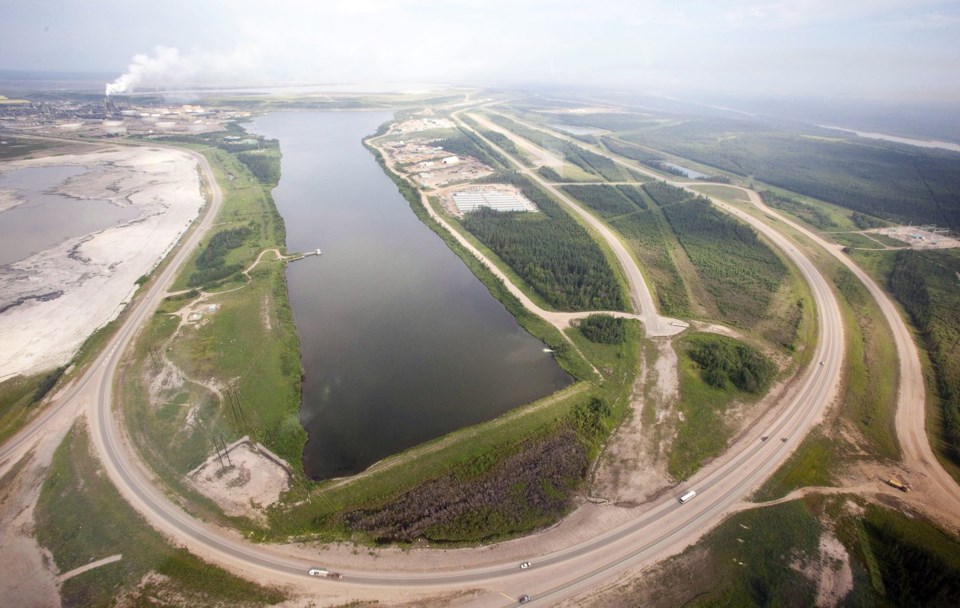EDMONTON — The Alberta government says it is considering letting oil companies inject wastewater deep underground as a way to manage the toxic tailings that are accumulating in the oilsands.
The idea is one of five policy recommendations being put forward by a government-appointed committee tasked with studying potential tailings management options.
A new report from the committee, which was formed over a year ago and is chaired by United Conservative MLA Tany Yao of Fort McMurray, says injecting mine water underground is a practical solution -- but considering over 1.4 trillion litres of tailings exist as of 2023, it can't be the only option.
"The accumulation of (oilsands mine water) represents a management challenge, particularly in the absence of established water release standards," the report reads.
"This approach helps to mitigate the continued accumulation of (tailings) and provides a buffer while longer-term water management strategies are being developed and implemented."
The report doesn't say exactly how much of the existing tailings volume it recommends to be disposed of in this way, but that "regulated limits should be placed on the volume of water that can be injected."
The committee's report says underground disposal of tailings — which are mixtures of water, sand, bitumen residue and chemicals — wouldn't ruin sources of drinking water as the wastewater would be disposed of underneath many layers of impermeable rock.
However, the report says there are a number of factors that would make underground disposal at a major scale a costly and lengthy endeavour.
New infrastructure and pipelines would need to be constructed since "there are limited geologically suitable deep well disposal sites" close to the oilsands, and if new underground wells are to be drilled the timeline for approval and consultation also "may not contribute towards an accelerated strategy to manage and reduce accumulated (tailings) on the landscape."
The committee — which includes former Alberta environment minister Lorne Taylor and University of Alberta engineering professor and Canada Research Chair in sustainable and resilient wastewater treatment for reuse Dr. Mohamed Gamal El-Din — also wrote that this disposal method would be in direct competition with carbon capture and storage projects for underground space.
Aliénor Rougeot, the senior program manager of climate and energy with advocacy group Environmental Defence, said she's happy to see the Alberta government recognize the urgency of the tailings ponds, but she's skeptical underground disposal is as safe as the committee is making it out to be.
"I don't know that we are at a stage where we could even say if we can safely inject anything down there," she said, adding that any tailings disposed underground would have to be treated completely.
In a letter accompanying the recommendations, Yao wrote that the committee "is satisfied" that technology exists to treat and safely release tailings water.
Rougeot said such a claim is news to her.
"If they have a solution to fully treat the water to a quality that's good enough to be put into the environment, that water should be good enough to be back into the production process," she said, noting the committee's report states oilsands mining operations use about 220-billion litres of fresh water every year.
Rougeot said if the government is serious about tackling the problem of tailings in the oilsands it should make a requirement that companies can no longer use fresh water in their mining operations, especially if the technology exists to treat it to a degree that's safe for environmental release as Yao wrote.
"There's more than enough existing tailings volumes to meet all the needs of all the production on a given day," she said.
"I want to see first a 100 per cent reuse rate of the existing tailings, and then we can talk about disposal."
Another recommendation being made by the committee is for Alberta to make policy changes to encourage companies to share wastewater across different types of oil mining facilities in order to reduce the need for freshwater use, and therefore the production of further tailings.
Environment Minister Rebecca Schulz said in a government release Thursday that her ministry will evaluate the committee's recommendations over the next six months before implementing a new tailings management plan.
“We need to start finding a path to more effectively manage oilsands mine water and tailing ponds," Schulz said.
"Doing nothing while mine water continues accumulating is not a sustainable approach.”
NDP environment critic Sarah Elmeligi agreed with Rougeot, saying in a statement that injecting tailings underground would be "irresponsible because we don’t know the risks involved to groundwater or geological stability."
"Nothing in these proposed methods remotely comes close to addressing future environmental and health impacts and we have already seen many Indigenous communities living downstream continue to deal with these consequences,” Elmeligi said.
This report by The Canadian Press was first published June 12, 2025.
Jack Farrell, The Canadian Press


